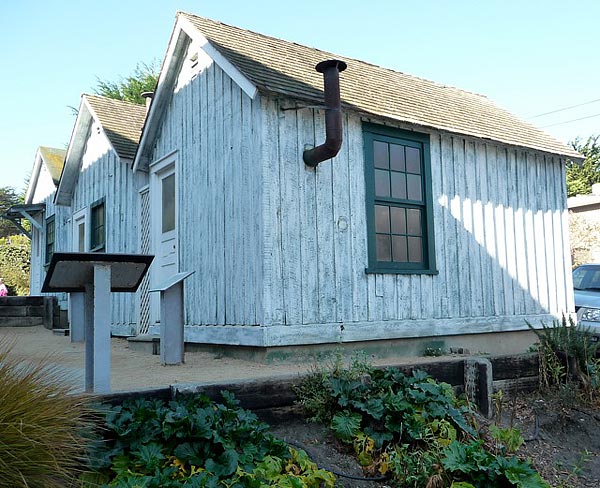Ben Wheeler visited Cannery Row and the Aquarium in Monterey, California and shot a few photos of some worker’s shacks that were on display.
A chorus of cannery whistles, each with its own unique call, summoned the Cannery Row workforce. Men and women in rubber boots and oilcloth aprons showed up to clean, cut, pack, cook and can the sardines that were a major part of Monterey’s economy for more than three decades.

The work was dirty and hard, cold and wet, and the smell was terrible–but it was the smell of prosperity. The stench of sardines, reduced to fertilizer, fish meal, and chicken feed, permeated the Row.
At least a half-dozen languages could be heard over the din of canning machinery. The men operated and maintained the equipment and warehoused and shipped the finished product. The women worked the packing lines, filling Cannary Row’s trademark one-pound oval cans with sardines and salmon. Until the formation of the Cannery Workers Union in 1936, wages averaged 25 cents per hour.

At the peak of the 1941-42 season, the canneries packed 250,287 tons of fish. However, the industry’s capacity to harvest soon outdistanced the sardines’ ability to reproduce, and the fishery crashed. When asked at the end of the 1947-48 season where all the sardines had gone, Ed Ricketts replied, “They’re in cans.”


I wonder what the dimensions are, do you know? I’m sure we could guestimate, but they look bigger on the inside than out. Wish there were more interior photos.
Looks like about 10′ x 14′, two rooms, outside plumbing, probably.
Unfortunately the term ‘workers shacks’ denigrates the potential dignity of having work and owning a home this size, much better than renting a bigger dump or having no home or job.
Looks comfy.
Great post! Monterey and Cannery Row are well worth a visit. I highly recommend reading John Steinbeck’s “Cannery Row” before you go.
Clayton: I certainly don’t know for sure, but I doubt the workers owned the shacks. At 25 cents an hour, and after the boozing and whoring, there likely wasn’t much left over for real estate investment.
They did not own the shacks. Whole families lived in them, sometimes two. It was not comfy. The hours were long, the work hard and tedious, and often dangerous. Do read Steinbeck’s “Cannery Row”, whether you go visit the cabins or not. And please don’t confuse the tiny house movement with the kind of worker’s housing these structures represent. These are just about the cream of the crop.
What a wonderful piece of history…
They look an awful lot like ‘Earthquake shacks’ that were given to displaced people after the San Francisco earthquake of 1906.
http://www.outsidelands.org/shacks.php
Does anyone know exactly where these are? I live within walking distance of Cannery Row, and would love to take a stroll down there to see these this weekend.
The link to the San Francisco earthquake shacks lists two sizes:
Type a: 10 x 14
Type b: 14 x 18
These would appear to be closer to type b size based on the interior photos
Are they for sale? very interested.
No they are not, sorry!
These shacks used to be behind our house on our property on Wave street, when I was a teenager. The Monterey Bay Aquarium purchased the home and later moved these shacks down the trail aways. The last time I saw them, the one I used for a “playhouse”, still had my wicker peacock chair in it on display. It’s nice to know I am part of that history too now.